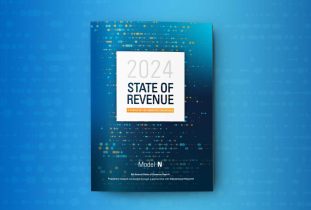By Cesare Rotundo, VP of Product Management, High Tech
Backdrop: The power of AI/ML has grown exponentially in the last few years. Is it time to apply AI/ML to pricing to generate value in complex environments like the multi-tier B2B High Tech channel?
AI/ML for B2B Pricing: Goal and Challenges
When it comes to Artificial Intelligence (AI), since its initial application around 2010 to B2B pricing, branching out from its earlier successes in B2C pricing, its natural target has been the identification of the “optimal price”. While there are different dimensions along which “optimal” can be measured, from a pure financial standpoint whereas the value of a company is reflected in its stock price, and where the stock price is driven by long-term profit, optimal price has in most cases been defined as the margin-maximizing price, and sometimes as the revenue-maximizing price.
The lure of optimal pricing is more than justified: in the Model N State of Revenue 2021 report we surveyed over 300 C-level executives. 75% of these executives stated that their pricing operations were leaving money on the table, and 89% of executives estimated the impact across the High Tech industry to be billions of dollars. Wouldn’t we all want small percent of that in our bottom line?
Clearly, determining the optimal price in B2B is not easy. Pricing is typically segmented by end market, geographic regions, channels, and even specific customer types. The same product can have multiple “List prices” and different price curves and volume breaks based on any one or combination of multiple segmentation considerations. On top of that, pricing business rules modify the price for regions or segments. Contracts are set up for end customers that impact the manufacturer and the distributor margin. Price concessions are made on quotes to distributors that change both the distributor’s cost and the end customer price. Can all this be optimized, is optimizing one stage in this pricing lifecycle negatively impact other stages?
To avoid these additional intricacies the focus of the B2B Optimization solutions circa 2010 converged towards the “last mile” of pricing determination: the price on a deal, or the price on a quote. That’s when all the pricing adjustments by region, segments, etc. are faced with reality: your partner needs additional support to sell to an end customer.
This “deal level pricing” can become the rule rather than the exception in B2B tech buying. Clearly not ideal, given the high volume of transactions. Too many special price agreements dilute the attention from the strategic deals that would really deserve special treatment. High Tech companies running Ship & Debit processes pay the difference between the Distributor Book Cost (acquisition cost) and the final price paid by the channel upon end customer sale and sometimes upon credit claim reception. The bigger the delta the smaller the manufacturer’s margin. Therefore, submitting deals thru an approval process increases the margin, but It also requires time, and it slows down response time. Especially for more commoditized products, responding within 24 hours rather than in 2 hours may mean losing the deal. The balance between customer service and responsiveness, between margin and revenue, is a delicate one.
The best companies set up complex workflows able to route approvals as needed by managing approval level thresholds based on deal type, deal size, product type, and the requested discount. Setting up thresholds pays off: auto-approving deals or requiring approvals at different levels based on different thresholds can help limit losses while decreasing the numbers of deals being touched. Yet it’s a lot of work and requires a lot of discipline.
Artificial Intelligence has naturally been a good candidate to support good processes with good data, potentially being a good fit for both determining an optimal deal price and approval thresholds. However, results have been mixed, most of them not delivering the expected value, or in the words of some High Tech manufacturers, “not even close”. To understand why we must look into the “black box” that is AI/ML.
Black Boxes: Good but with Challenges
The first question is: are black boxes good? Black boxes are all around us, we use the ones that we find useful without much thinking, yet we hate the ones that don’t work. AI/ML has been touted as revolutionary, and it’s been working well in B2C, just think about how well Netflix seems to know which movies you like. It’s still a black box, the algorithm behind the screen doesn’t really know you, hasn’t asked you what you like, yet it works.
When it comes to the less mundane world of business, we like to be able to explain what’s happening. To do that, we apply the amazingly sophisticated deduction power of our brains. We make informed inferences based on our deep knowledge of the business, and we apply experience. This works well at small scale: we deduce patterns based on the few examples that we run thru and apply to the next. However, we can’t process a lot of deals.
What if AI/ML could scale up that deductive process, after all, the “I” in AI stands for Intelligence! That’s possible in theory, but in practice … “not even close”. Why? Today, AI is still about brute force, our brains are anything but brute, we make deductions by comparing data across a few dimensions, we’re used to data scarcity. For AI to learn, it needs lots of data. That’s where the “A” in “AI” comes in. Less intelligent, less deductive, but lots of number crunching.
The problem in a multi-tier B2B environment is that while there are plenty of transactions, there are also a lot of dimensions. AI/ML needs the same patterns to repeat along the same dimensions, and when the number of dimensions grows, the number of combinations of those dimensions grows exponentially. A B2B channel quote has a part, a channel, a purchasing customer, and end customer, a quantity, and most of these dimensions have a hierarchy: part has a product hierarchy and a lifecycle; partners and customers have a geography hierarchy. Plus, a quote can have contracts linked, rebates embedded. As a business expert, you may intuitively think that some of these dimensions are more relevant than others, just to find out that the data doesn’t empirically support your assumptions. The paradox is that no transaction may be compared to another unless they’re identical, and even if they’re identical, the time they are placed is different.
In part 2, we’ll discuss the machine learning (ML) revolution and how targeting the right business issues, and ultimately building AI/ML models can solve those business issues. If you’d like to learn more about Model N’s price optimization approach, go here.
















